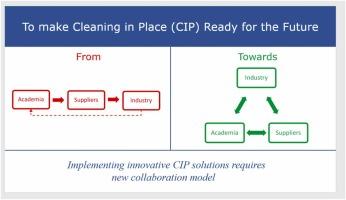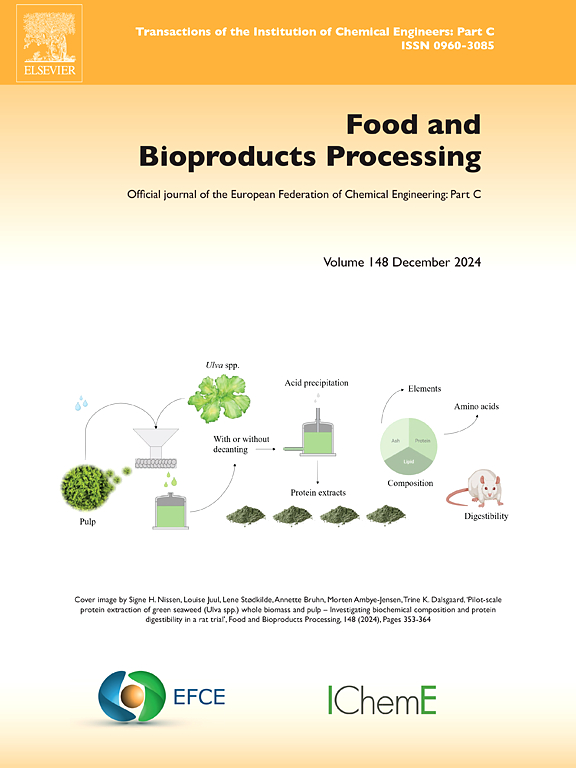Is cleaning in place (CIP) ready for the future? - A critical assessment
IF 3.4
2区 农林科学
Q2 BIOTECHNOLOGY & APPLIED MICROBIOLOGY
引用次数: 0
Abstract
In the dairy industry, Cleaning in Place (CIP) is one of the most frequently applied unit operations with 10 – 20 % of the total production time being consumed by CIP operations. Therefore, CIP has a significant impact on Operational Equipment Effectiveness (OEE) and on carbon (10 – 20 %) and water (20 – 30 %) footprints. Like many other industries, the dairy industry must reduce its environmental impact in the coming years and improving CIP practices can clearly contribute to this goal. Science has revealed innovative methods of cleaning during the last decades. However, despite more than 50 years of fouling and cleaning research in the scientific community, industrial cleaning operations have not fundamentally changed. For example, alkaline and acid solutions are still the primary cleaning solutions. Detergent manufacturers have focused on developing “more sustainable” cleaning formulations, but the adoption of these alternatives is lagging, except for specific applications of enzymatic detergents. Moreover, food product manufacturers are reserved to change because cleaning is crucial for ensuring food quality and safety. So, how can we overcome this “Catch 22”? What is needed to ensure that (new) solutions from the scientific community are adopted by industry? This review aims to provide a direction to bridge the gap between science and industry. This is crucial to make a turnaround in cleaning practices and prepare CIP for the future challenges. Open collaboration and innovation between all players, in combination with a united long-term outlook, will be needed to solve the future challenges of CIP.

就地清洁(CIP)是否为未来做好准备?-关键评估
在乳制品行业,就地清洗(CIP)是最常用的单元操作之一,CIP操作消耗了总生产时间的10 - 20% %。因此,CIP对运营设备效率(OEE)、碳足迹(10 - 20% %)和水足迹(20 - 30% %)有显著影响。与许多其他行业一样,乳制品行业必须在未来几年减少对环境的影响,而改进CIP实践显然有助于实现这一目标。在过去的几十年里,科学揭示了创新的清洁方法。然而,尽管科学界对污垢和清洗进行了50多年的研究,但工业清洗操作并没有从根本上改变。例如,碱性和酸性溶液仍然是主要的清洁溶液。洗涤剂制造商一直致力于开发“更可持续”的清洁配方,但除了酶促洗涤剂的特定应用外,这些替代品的采用滞后。此外,由于清洁是确保食品质量和安全的关键,食品制造商保留了改变。那么,我们如何才能克服这个“第22条军规”呢?需要什么来确保科学界的(新)解决方案被工业界采用?本文旨在为弥合科学与工业之间的差距提供一个方向。这对于清洁实践的转变和为CIP未来的挑战做好准备至关重要。所有参与者之间的开放合作和创新,结合统一的长期前景,将需要解决CIP未来的挑战。
本文章由计算机程序翻译,如有差异,请以英文原文为准。
求助全文
约1分钟内获得全文
求助全文
来源期刊

Food and Bioproducts Processing
工程技术-工程:化工
CiteScore
9.70
自引率
4.30%
发文量
115
审稿时长
24 days
期刊介绍:
Official Journal of the European Federation of Chemical Engineering:
Part C
FBP aims to be the principal international journal for publication of high quality, original papers in the branches of engineering and science dedicated to the safe processing of biological products. It is the only journal to exploit the synergy between biotechnology, bioprocessing and food engineering.
Papers showing how research results can be used in engineering design, and accounts of experimental or theoretical research work bringing new perspectives to established principles, highlighting unsolved problems or indicating directions for future research, are particularly welcome. Contributions that deal with new developments in equipment or processes and that can be given quantitative expression are encouraged. The journal is especially interested in papers that extend the boundaries of food and bioproducts processing.
The journal has a strong emphasis on the interface between engineering and food or bioproducts. Papers that are not likely to be published are those:
• Primarily concerned with food formulation
• That use experimental design techniques to obtain response surfaces but gain little insight from them
• That are empirical and ignore established mechanistic models, e.g., empirical drying curves
• That are primarily concerned about sensory evaluation and colour
• Concern the extraction, encapsulation and/or antioxidant activity of a specific biological material without providing insight that could be applied to a similar but different material,
• Containing only chemical analyses of biological materials.
 求助内容:
求助内容: 应助结果提醒方式:
应助结果提醒方式:


